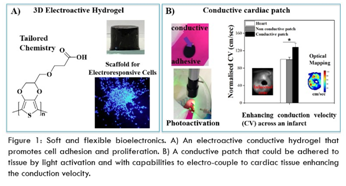
Damia Mawad
University of New South Wales, Australia
Title: Flexible and soft bioelectronics for the biotic/abiotic interface
Biography
Biography: Damia Mawad
Abstract
Statement of the Problem: Damaged electroresponsive tissues such as spinal cord injuries and myocardium infarctions malfunction due to disruption in the bioelectric signal propagating along the tissue. Flexible and soft organic bioelectronics are being explored as biomaterial-based approaches applied on the biotic/abiotic interface to electro-couple with the tissue and restore the electric signal. However, the clinical application of organic conducting polymers (CPs) has been mainly hindered by their short term operational lifetime in physiological conditions and their hydrophobicity that impedes nutrients transfer needed for cell survival. Furthermore, fixing these flexible bioelectronics on soft tissue can be challenging and requires invasive suturing techniques. The purpose of this research is to develop novel bioelectronics with tailored chemistries that address the aforementioned limitations with proven electrophysiological effect on electroresponsive tissues such as the heart. Methodology: By manipulating the chemistry of conjugated backbones, conductive constructs such as a hydrogel doped with large polyelectrolyte or free standing patch doped with small anion were fabricated. The chemical components of the patch permitted adhesion to tissue by light activation. In vitro and in vivo experiments were conducted to investigate how these conductive scaffolds interact with tissues. Findings: New generation CPs were synthesized with demonstrated biocompatibility and ease of processability. The conductive hydrogel is demonstrated to be a suitable 3D hydrated network that promotes the proliferation of C2C12 muscle cells and exhibits electroactivity in physiological media (Fig. 1A). The patch is shown to have an extended electronic biostability, adheres to tissue without the need of sutures and electro-couple with infarcted cardiac tissue enhancing the conduction velocity of the electric signal across scar tissue (Fig. 1B). Conclusion & Significance: By modifying the chemistry of CPs, these macromolecules could be fine-tuned into functional materials opening the way for the development of novel multifunctional bioelectronics capable of electro- coupling with biological tissues.



